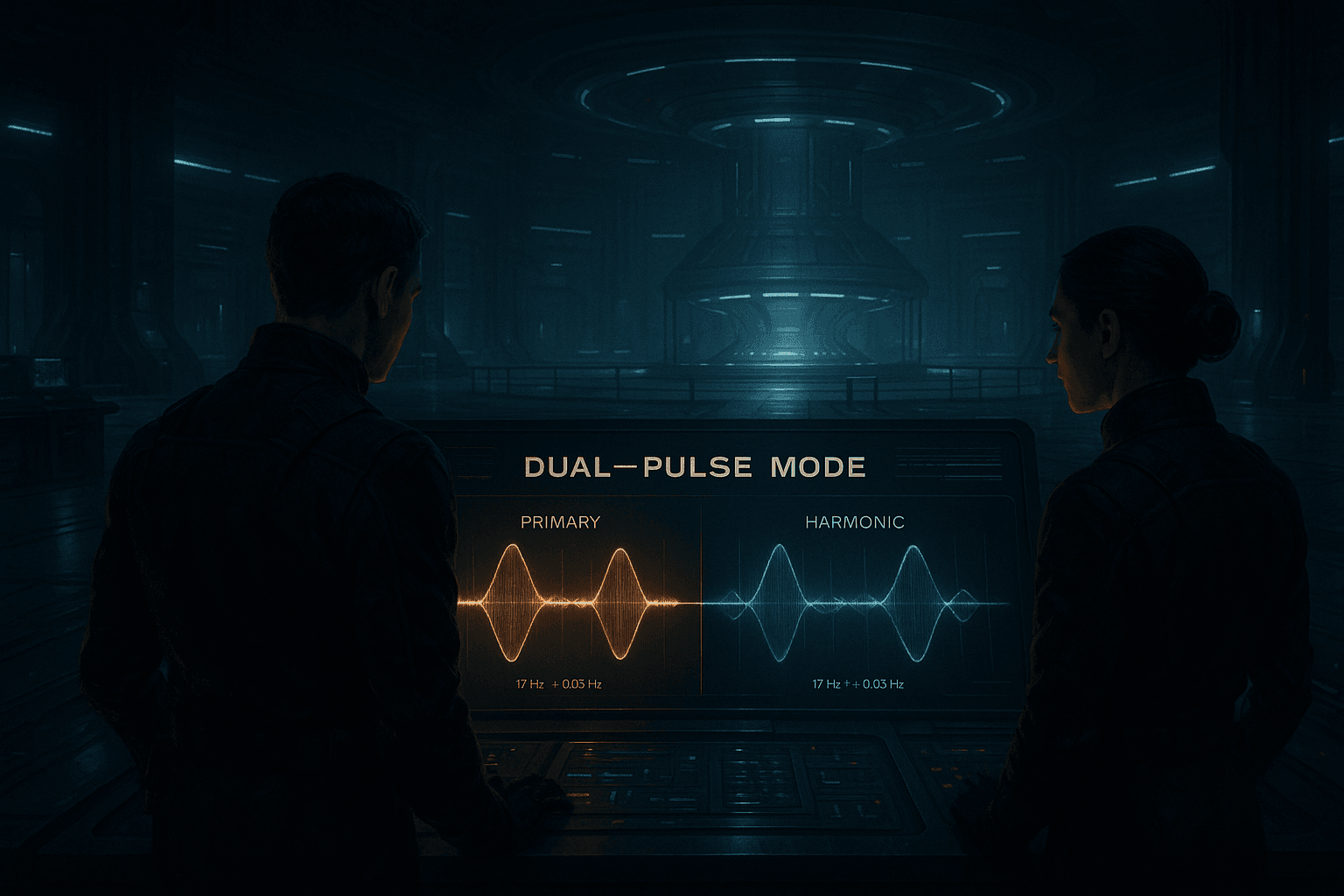Dual-Pulse Mode Operation
Two pulses in perfect harmony — the key to walking the Leyweb.

The Dual-Pulse Mode is the refined operational method that allows Fort Resonance to access the Leyweb, a multidimensional lattice of resonance-linked worlds. It is the rhythm, timing, and alignment of two pulses — not just their presence — that makes safe traversal possible.
The Core Concept
Every corridor begins with two distinct 16-bit binary pulses: a Primary Pulse and a Harmonic Pulse. The primary aligns with the base resonance of the target world; the harmonic locks that phase into coherence. Without this second element, stability collapses in seconds. The pulses must be completely unique — identical values are rejected by the lattice itself.
In Dual-Pulse Mode, these signals oscillate at 17 Hz ± 0.05 Hz in a precisely alternating pattern, Primary ↔ Harmonic, with jitter no greater than 8 milliseconds. This oscillation must remain perfectly stable for at least 90 seconds before a corridor is considered viable. The limit is strict: break stability before 90 seconds, and the process resets; maintain it beyond the maximum of 900 seconds, and the corridor naturally collapses.
The Buildup Sequence
When operation begins, the first seconds are almost uneventful. Between 0–30 seconds, the system is in passive intake — invisible to the naked eye. At 30–60 seconds, subtle floor vibrations start, dust rises from the emitter platform, and a low hum fills the air. By 60–90 seconds, invisible filaments are converging within the chamber, sensors detect microgravity flickers, and the air itself begins to ionize. If stability is maintained, at the 90-second mark a 432 Hz chime confirms corridor viability.
From this point forward, the corridor remains open for up to 15 minutes — a fixed travel window before harmonic decay. Within that time, teams must enter and, if needed, return before closure.
Why It Works
The theory behind Dual-Pulse Mode emerged from early failures in single-pulse experiments. These earlier tests produced strange effects — mirage-like flickers, mild hallucinations, and unpredictable temperature spikes — but never formed a stable braid. The breakthrough came when a harmonic signal was introduced mid-cycle. Instead of collapsing, the lattice stabilized, holding open long enough for controlled testing. That day became the foundation of every mission since.
The harmonic element is not just a stabilizer — it is a handshake with the Leyweb, a second voice in the conversation. The primary says, “Here is our address”; the harmonic says, “We are meant to be here.”
The Operator’s Role
Although AI-assisted systems handle frequency calibration, human operators remain essential. They read the subtle cues in waveform behavior, anticipate fluctuations, and make split-second adjustments. Their eyes stay fixed on oscillation readouts, while their hands hover near manual override controls.
Each step — from initiating ARK authentication to injecting the pulse pair into the manifold — is part of a choreography learned over months of training. The slightest misstep can mean the difference between a mission launch and a collapsed braid.
The Legacy
Today, Dual-Pulse Mode is not just a technical process; it is a ritual within Fort Resonance. Operators describe it as a kind of resonance “dance,” a moment when Earth’s technology and the Leyweb’s physics meet in precise harmony. Every successful activation is another confirmation that the human race has learned the first steps in navigating an infinite, invisible network.
From the 90-second wait to the 15-minute travel window, the Dual-Pulse Mode remains the disciplined heartbeat of interworld exploration — two pulses in perfect sync, holding open a path to the unknown.
